Solar Eclipse Paintings On View in New Princeton Exhibit (Photos)
Solar Eclipse, 1923
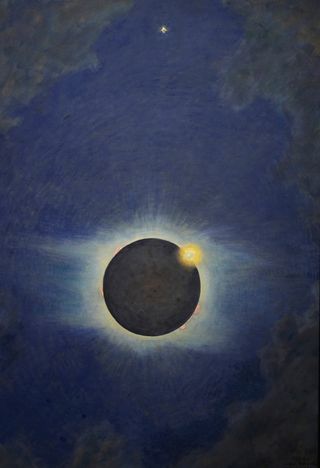
A new exhibit at the Princeton University Art Museum was inspired by the work of an extraordinary artist who harnessed both scientific knowledge and artistic practicality to produce mesmerizing paintings of the brief moments present in solar eclipses in the early 20th century.
This image shows an eclipse occurring at noon, and the diamond-ring effect is called Baily's beads. Lisa Arcomano, manager of campus collections at the Princeton University Art Museum, spoke with Space.com on Aug. 4 when we visited the exhibit, called "Transient Effects: The Solar Eclipses and Celestial Landscapes of Howard Russell Butler." Arcomano said Baily's beads occur when "the sun is coming through the two mountain ranges or the volcanic regions that are on the moon." [Total Solar Eclipse 2017: When, Where and How to See It (Safely)]
Transient Effects Gallery
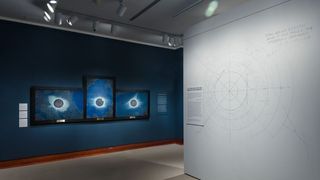
The Transient Effects exhibit, which opened July 22 and runs until Oct. 15, showcases Butler's final renderings of solar eclipses and landscapes, as well as imagined lunar views. The exhibit also includes reproductions of Butler's many meticulous notations, which he made during the few moments of each of the four solar eclipses he documented in these paintings. The notes give visitors a window into the mind of the artist, who was part scientist, part painter.
Butler graduated from Princeton's first school of science in 1876, illustrated for Thomas Edison and achieved a law degree in 1882. Ultimately, he decided to use his scientific background in a nontraditional manner: to develop a new career in painting. According to Arcomano, his first venture was to accompany Hudson River School landscape painter Frederic Edwin Church to Mexico in 1884, and later relocated to Long Island. Butler became well known among the local artistic community, which led him to get invited on special eclipse expeditions.
Solar Eclipse, 1918

Butler became especially known for capturing momentary scenery, and for his methodology of writing down what he saw in shorthand. Butler's ability to beautifully reproduce the moment from those quick notations caught the attention of amateur astronomer Edward Dean Adams, who invited Butler to be the artist in residence for his 1918 solar eclipse expedition to Oregon, according to the Transient Effects website. Butler would jot down three color theory components as he viewed an eclipse: form, color and value. He timed and practiced this technique so that when the brief total solar eclipse appeared, he would be ready to capture the instant of totality, when, for just a few minutes, the sun's disk would be completely covered by the moon.
When Arcomano began her work as a curator, a member of the Asian art division told her that she had to find these astronomically themed paintings, which used to be displayed at Princeton. As she would come to find out, the mysterious paintings were unforgettable to many people.
Approach of the Moon's Shadow
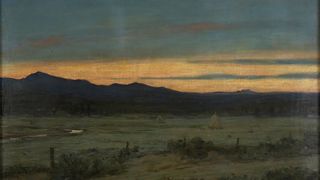
It might appear as though a seemingly simple landscape like this painting would be easier for Butler to produce than his other works. However, looks are deceiving: Arcomano revealed that what appears to be a sunset landscape is actually the shadow of the solar eclipse swiftly passing over the Oregon sky in 1918.
In Arcomano's search for Butler's paintings, she discovered that at one point, the artwork had been accidentally removed from Princeton's campus and put on a loading dock during a renovation. But the paintings were saved and protected in a less-than-ideal location: a broom closet. Arcomano retrieved them and found locations for them on campus.
Eclipse Sketch, 1918

"Under ordinary circumstances, the kind of picture I wanted to paint would have taken 10 to 12 sittings," Butler said in 1918 at a Metropolitan Museum of Art lecture about how he managed to capture the eclipse. "I knew I should devise some swift system."
Butler spent the two minutes of that total solar eclipse taking down observations, seen here in this drawing. To aid his note taking, which was done with only a pencil and white cardboard, he had another chart outlining how many seconds he could spend jotting down each aspect of the eclipse, according to the Transient Effects website. The details he wrote down included the numbers of the colors according to a value scale that would identify the shades he saw present in the sky, moon, clouds, the outermost part of the sun known as the corona and hydrogen flames that often blaze off the sun's surface. He did not waste time making the pencil outline perfect, and sometimes used photographs to note down less important details later on. [Enjoy an Eclipse Safari! Total Solar Eclipse App Features Interactive Map and Space.com News]
The Eagle Prominence
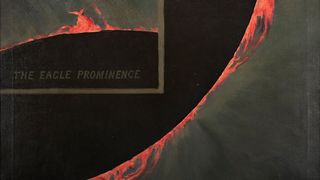
Butler's many eclipse paintings made astronomy more accessible to the general public, and he later became active in outreach at science museums as well.
As seen here in Butler's 1918 painting "The Eagle Prominence," Butler highlighted an eagle-shaped solar flare on the sun's surface, which, according to Arcomano, added a memorable touch to the scientifically valuable painting. Butler also noted that in this painting, he aimed to capture the "many arches … found springing over the prominences, and a few rifts or dark channels radiating from the limb but never coming very close to it."
Solar Eclipse, 1925
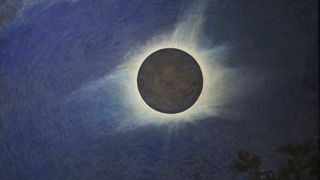
For the 1925 solar eclipse, Butler chose to plant himself on the roof of the Arrigoni Hotel in Connecticut, to view the direction from which the moon's shadow was approaching and to establish a clear view of the sun. In this painting, Butler followed his methodology to document color values of the corona.
Arcomano created the exhibit with the assistance of another admirer of Butler's work, the physicist Rolf Sinclair. A few years after Arcomano installed the paintings, she got a call from Sinclair, who is a visiting senior research scholar at the University of Maryland in College Park and had been interested in Butler's work for a long time. Sinclair was giving a lecture in England about the paintings, and wanted to see them in person beforehand, so Arcomano gladly agreed to meet with him at Princeton. "I mean, I knew they were kind of fun paintings, but I didn't realize that they had that kind of pull," she told Space.com. Sinclair and Arcomano thought about doing an exhibition but decided to put up a website instead, at first. They brought in artistic and scientific experts. An opportune moment came to install a standing exhibit with the news of the approaching 2017 total solar eclipse.
Triptych

Butler was an advocate for science education. He collaborated with the American Museum of Natural History in New York for several years, and designed a copy of this triptych — a three sectioned work of art — for an ambitious seven-story astronomy hall. Although the trio of paintings was installed above the museum's Hayden Planetarium entrance in 1930, the museum renovation, which included the pending new astronomy hall, was never built. This was likely due to the stock market crash of 1929, Arcomano said. Princeton University has its own copy of the triptych, which depicts the 1918, 1923 and 1925 total solar eclipses. There are two other triptychs on display: one at The Franklin Institute in Philadelphia, and another at the Buffalo Museum of Science in Buffalo, New York.
Northern Lights, 1919

Butler got quite lucky on Aug. 11, 1919, when he caught another solar phenomenon playing out across the sky. He saw an aurora borealis (the northern lights) while he was sketching an evening scene of Bald Head Cliff, Maine, where he had a studio. Butler wrote that "this wonderful display suddenly appeared, flooding the heavens with light," lasting about 20 minutes. "I was working on dark gray paper with black and white, with no light but that of the moon and the aurora itself," he wrote. He relied on the techniques he acquired to capture transient moments such as solar eclipses to write down the color values quickly for later painting.
Join our Space Forums to keep talking space on the latest missions, night sky and more! And if you have a news tip, correction or comment, let us know at: community@space.com.
Get the Space.com Newsletter
Breaking space news, the latest updates on rocket launches, skywatching events and more!

Doris is a science journalist and Space.com contributor. She received a B.A. in Sociology and Communications at Fordham University in New York City. Her first work was published in collaboration with London Mining Network, where her love of science writing was born. Her passion for astronomy started as a kid when she helped her sister build a model solar system in the Bronx. She got her first shot at astronomy writing as a Space.com editorial intern and continues to write about all things cosmic for the website. Doris has also written about microscopic plant life for Scientific American’s website and about whale calls for their print magazine. She has also written about ancient humans for Inverse, with stories ranging from how to recreate Pompeii’s cuisine to how to map the Polynesian expansion through genomics. She currently shares her home with two rabbits. Follow her on twitter at @salazar_elin.
